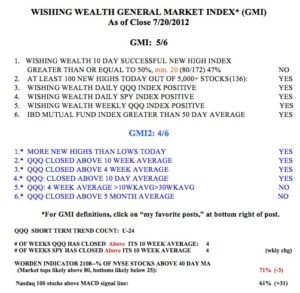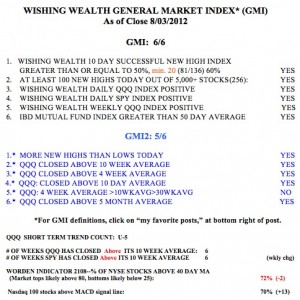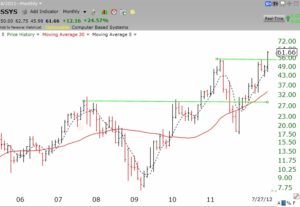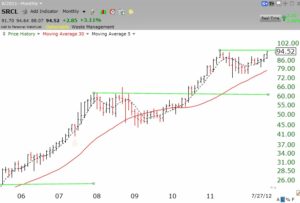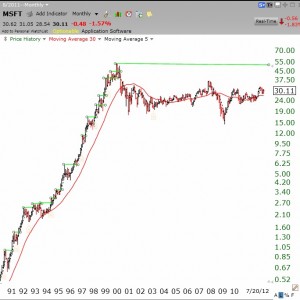With the QQQ short term up-trend reaching its fifth day, I am more confident of this new up-trend. I am gradually going long and am adding to my position in QLD. The GMi is now at 6 (of 6) and the Buy signal issued at the close on July 30 remains in place.
General Market Index (GMI) table
GMI rebounds to 5; can market hold? SSYS, SRCL green line charts
The GMI has rebounded to 5 (of 6) and if it holds on Monday, the GMI will give a buy signal. 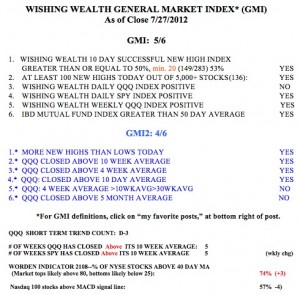 The market has been erratic and IBD switched to “market in a confirmed up-trend” last last week. I closed out my shorts and have made a few buys. This could merely have been end-of-month buying and it will be interesting to see if August will hold the gains. After earnings are out, the market often calms down until the beginning of the next quarter’s earnings announcements, sometime in late October or November. Remember, the Sell in May slogan says to buy back into the market around Halloween……
The market has been erratic and IBD switched to “market in a confirmed up-trend” last last week. I closed out my shorts and have made a few buys. This could merely have been end-of-month buying and it will be interesting to see if August will hold the gains. After earnings are out, the market often calms down until the beginning of the next quarter’s earnings announcements, sometime in late October or November. Remember, the Sell in May slogan says to buy back into the market around Halloween……
I introduced green line charts last week. I scanned for stocks hitting a new high Friday and created green line charts for most of them. I am looking for a stock that hit a 52 week high and is breaking out of a multi-month base towards an all-time high. An example of what I am looking for is shown in this monthly green line chart of SSYS. This stock is probably worth researching. One important factor to look for is the next earnings release date. Click on chart to enlarge.
SRCL is one of those stocks hitting a 52 week high that is just below its green line top ($95.71). I placed an alert in TC2000 to tell me if SRCL trades above 95.
24th day of QQQ short term up-trend; Stage analysis and green line charts
Over 120 persons attended my AAII workshop presentation. It was great to meet some of my blog readers and to hear their personal stories regarding its value. I talked a lot about stage analysis and buying stocks at all-time highs. I thought I would comment on both today.
Stage analysis was introduced by Stan Weinstein in his book in the early 1980’s, listed to the bottom right of this blog. I told people that I only buy long when the market is in a Stage 2 up-trend and if the stock or ETF I am buying is also in a Stage 2 up-trend. The SPY is currently in a Stage 2 rise, as shown by this weekly chart of the SPY (S&P 500 ETF). Click on chart to enlarge.
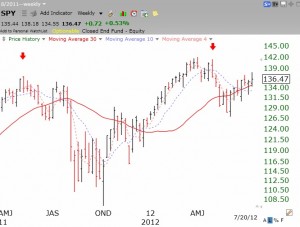 Note that the SPY is following along its 30 week average (red line). When the QQQ or SPY closes below this important average, I tend to get very defensive. I make no new buys and raise my stops. If this average eventually turns down, I typically get out of the market. One component of the GMI counts whether the QQQ has closed above its 30 week average…….
Note that the SPY is following along its 30 week average (red line). When the QQQ or SPY closes below this important average, I tend to get very defensive. I make no new buys and raise my stops. If this average eventually turns down, I typically get out of the market. One component of the GMI counts whether the QQQ has closed above its 30 week average…….
A second major point I made was that major market winners rise for a while and then rest in a base for several months and then break out of the top and repeat this cycle until the rise ends. I introduced to the attendees the “green line charts” of past winners. A horizontal green line is drawn on a monthly chart once a stock has risen to a new all-time high and then stays below the high for 3 or more months. By taking a look at past winners one can readily see the value of this approach. Take a look at this monthly chart of MSFT. Click on chart to enlarge.
Note the many bases formed along its huge run from 1990 until 2000. This is what a rocket stock looks like. Anyone who was afraid to buy MSFT after the stock formed a multi-month base and broke to a new high lost out on a huge gain. After forming the top in 2000, MSFT has gone nowhere and is not worth buying or holding, according to my methods. When it closes above its 2000 high, I might become interested in buying MSFT, but don’t hold your breath! The moral of the story is to buy stocks that appear on the new high list after breaking recently through a green line base to an all-time high. Whenever I run a scan on stocks at a new high, I draw in the green line tops to get an idea of whether the stock is breaking out of its top base.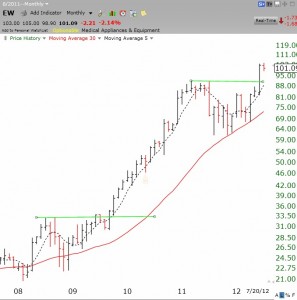 EW is a good example of such a stock. that may be worth researching……….
EW is a good example of such a stock. that may be worth researching……….
The GMI remains at 5 (out of 6) and the more sensitive GMI2 is at 4. The last GMI signal was a “Buy” on June 19. The QQQ also remains in a short term up-trend. For now, I am holding my long position and selling cash secured weekly puts on the SPY. Those of you who showed some interest in learning how to write covered calls, might look up Alan Ellman’s website or order his book listed to the lower right. The “Cashing In” book is a great primer on selling covered call options using technical analysis that is similar to mine.